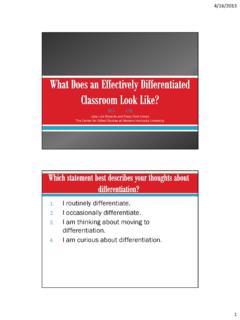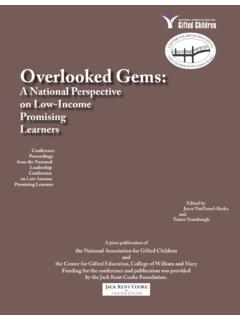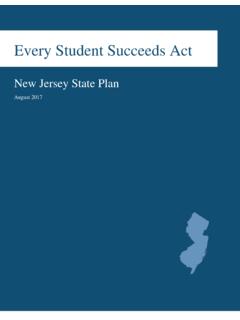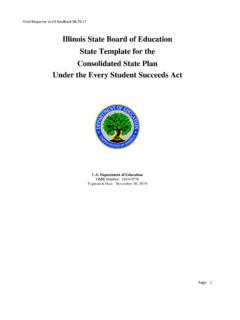Transcription of Gifted Education Provisions in Final Version of …
1 National Association for Gifted Children 1331 H Street, NW, Suite 1001 Washington, DC 20005 (202) 785-4268 Gifted Education Provisions in Final Version of ESEA the every Student Succeeds Act (page #s refer to Final conference report dated Nov 30, 2015) TITLE I Improving Academic Achievement of Disadvantaged Students Disaggregation of student achievement data at each achievement level on state & local report cards Sec. 1111. State Plans (p 38) (h)(1)(C) minimum requirements for state report cards (p 115) (ii) For all students and disaggregated by each subgroup of students described in subsection (b)(2)(B)(xi), homeless status, status as a child in foster care, and status as a student with a parent who is a member of the Armed Forces (as defined in section 101(a)(4) of title 10, United States Code) on active duty (as defined in section 101(d)(5) of such title)
2 , information on student achievement on the academic assessments described in subsection (b)(2) at each level of achievement, as determined by the State under subsection (b)(1). (pp 117-118) (h)(2)(C) Local Education Agency Report Cards Minimum requirements (same as required for state report cards) (p 125) Local Education Agency Plans may include information specifically about identifying and serving Gifted and talented students Sec. 1112. Local Education Agency Plans (p 131) (b) Plan Provisions (p 134) (13) any other information on how the local educational agency proposes to use funds to meet the purposes of this part, and that the local educational agency determines appropriate to provide, which may include how the local educational agency will (A) assist schools in identifying and serving Gifted and talented students; (p138) States using computer adaptive assessments Sec.
3 1111(b) Challenging academic standards and academic assessments (p 47) (b)(2) Academic assessments (p 52) (b)(2)(J) Adaptive Assessments (pp 73-76) (J) ADAPTIVE ASSESSMENTS. (i) IN GENERAL. Subject to clause (ii), a State retains the right to develop and administer computer adaptive assessments as the assessments described in this paragraph, provided the computer adaptive assessments meet the requirements of this paragraph, except that (I) subparagraph (B)(i) shall not be interpreted to require that all students taking the computer adaptive assessment be administered the same assessment items.
4 And (II) such assessment (aa) shall measure, at a minimum, each student s academic proficiency based on the challenging State academic standards for the student s grade level and growth toward such standards; and (bb) may measure the student s level of academic proficiency and growth using items above or below the student s grade level, including for use as part of a State s accountability system under subsection (c). (ii) STUDENTS WITH THE MOST SIGNIFICANT COGNITIVE DISABILITIES AND ENGLISH LEARNERS. In developing and administering computer adaptive assessments (I) as the assessments allowed under subparagraph (D), a State shall ensure that such computer adaptive assessments (aa) meet the requirements of this paragraph, including subparagraph (D), except such assessments shall not be required to meet the requirements of clause (i)(II); and (bb) assess the student s academic achievement to measure, in the subject being assessed, whether the student is performing at the student s grade level.
5 And (II) as the assessments required under subparagraph (G), a State shall ensure that such computer adaptive assessments (aa) meet the requirements of this paragraph, including sub-paragraph (G), except such assessment shall not be required to meet the requirements of clause (i)(II); and (bb) assess the student s language proficiency, which may include growth towards such proficiency, in order to measure the student s acquisition of English. Sec. 1201(a) State Assessment Grants authorized (p 206) (L) Evaluating student academic achievement through the development of comprehensive academic assessment instruments (such as performance and technology-based academic assessments, computer adaptive assessments, projects, or extended performance task assessments) that emphasize the mastery of standards and aligned competencies in a competency-based Education model.
6 (p 209) Title II Professional Development Including needs of Gifted learners required in state Title II applications Sec. 2101 Formula Grants to States (p 308) (d)(2) (p 326)) State Application Contents: Each application described under paragraph (1) shall include the following: (J) A description of how the State educational agency will improve the skills of teachers, principals, or other school leaders in order to enable them to identify students with specific learning needs, particularly children with disabilities, English learners, students who are Gifted and talented, and students with low literacy levels, and provide instruction based on the needs of such students.
7 (p 328) Local Education agencies including needs of Gifted learners with Title II funds Sec. 2103. Local Uses of Funds (p 335) (b)(2) Types of required activities (p 336) (b) TYPES OF ACTIVITIES. The programs and activities described in this subsection (2) shall address the learning needs of all students, including children with disabilities, English learners, and Gifted and talented students; and (b)(3)Types of permissible activities (p 336) (3) may include, among other programs and activities (J) providing training to support the identification of students who are Gifted and talented, including high-ability students who have not been formally identified for Gifted Education services, and implementing instructional practices that support the Education of such students, such as (i) early entrance to kindergarten; (ii) enrichment, acceleration, and curriculum compacting activities.
8 And (iii) dual or concurrent enrollment programs in secondary school and postsecondary Education ; (p 343) Title IV: 21st Century Schools Subpart 4 Academic Enrichment (p 625) Sec. 4644 Supporting High-Ability Learners and Learning. Javits Gifted & Talented Students Education Act (pp 636 642) For further information about the every Student Succeeds Act (ESSA), visit the NAGC website. For additional questions, contact Jane Clarenbach, NAGC Director of Public Education at










